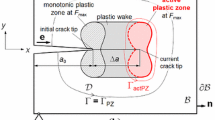Abstract
Nonproportional (NP) strain hardening is caused by multiaxial load histories that induce variable principal stress/strain directions, activating cross-slip bands in several directions, due to the associated rotation of the maximum shear planes. This effect increases the strain-hardening behavior observed under proportional loads, those with fixed principal directions, and must be considered in multiaxial fatigue calculations, especially for materials with low stacking fault energy, such as austenitic stainless steels. NP hardening depends on the material and on the shape of the multiaxial load history path in a stress or strain diagram as well. It can be evaluated by a nonproportionality factor \({F_{\rm NP}}\) that varies from zero, for a proportional load history, to one, for a \({90^{\circ}}\) out-of-phase tension–torsion loading with the same normal and effective shear amplitudes. Originally, \({F_{\rm NP}}\) was estimated from the aspect ratio of a convex enclosure that contains the load history path, such as an ellipse or a prismatic enclosure, but such convex enclosure estimates can lead to poor predictions of \({F_{\rm NP}}\). Another approach consists on evaluating the shape of the six-dimensional (6D) path described by the six normal and shear components of the stress tensor, where the stress path contour is interpreted as a homogeneous wire with unit mass. The moment of inertia (MOI) tensor of this hypothetical wire is then calculated and used to estimate \({F_{\rm NP}}\). The use of 6D stress paths to estimate \({F_{\rm NP}}\) is questionable, since 6D formulations implicitly include the effect of the hydrostatic stress, while NP hardening is caused by the deviatoric plastic straining, not by stresses alone or by their hydrostatic component. In this work, the NP factor \({F_{\rm NP}}\) of a multiaxial load history is estimated from the eigenvalues of the MOI tensor of the plastic strain path, which are associated with the accumulated plastic straining in the principal directions defined by the associated eigenvectors. The presented formulation assumes free-surface conditions, but allows a surface pressure, covering the conditions of most critical points, which indeed are located on free surfaces. Experimental results for 14 different tension–torsion multiaxial histories prove the effectiveness of the proposed method.
Similar content being viewed by others
References
Socie D.F., Marquis G.B.: Multiaxial Fatigue. Society of Automotive Engineers, Inc., Warrendale (2000)
Itoh T., Yang T.: Material dependence of multiaxial low cycle fatigue lives under non-proportional loading. Int. J. Fatigue 33, 1025–1031 (2011)
Itoh T., Sakane M., Ohnami M., Socie D.F.: Nonproportional low cycle fatigue criterion for type 304 stainless steel. ASME J. Eng. Mater. Technol. 117, 285–292 (1995)
Itoh, T., Sakane, M.: Evaluation of multiaxial low cycle fatigue life under non-proportional loading. In: Tenth International Conference on Multiaxial Fatigue & Fracture (ICMFF10), Kyoto, Japan (2013)
Doquet V., Clavel M.: Stacking-fault energy and cyclic hardening of FCC solid solutions under multiaxial non-proportional loadings. In: Pineau, A., Cailletaud, G., Lindley, T.C. (eds.) Multiaxial Fatigue and Design, ESIS 21, pp. 43–60. Mechanical Engineering Publication, London (1996)
Taleb L., Hauet A.: Multiscale experimental investigations about the cyclic behavior of the 304L SS. Int. J. Plast. 25, 1359–1385 (2009)
Shamsaei N., Fatemi A.: Effect of microstructure and hardness on non-proportional cyclic hardening coefficient and predictions. Mater. Sci. Eng. A 527, 3015–3024 (2010)
Shamsaei N., Fatemi A., Socie D.F.: Multiaxial fatigue evaluation using discriminating strain paths. Int. J. Fatigue 33, 597–609 (2011)
Shamsaei N., Fatemi A., Socie D.F.: Multiaxial cyclic deformation and non-proportional hardening employing discriminating load paths. Int. J. Plast. 26, 1680–1701 (2010)
Meggiolaro M.A., Castro J.T.P.: An improved multiaxial rainflow algorithm for non-proportional stress or strain histories—part I: enclosing surface methods. Int. J. Fatigue 42, 217–226 (2012)
Meggiolaro M.A., Castro J.T.P.: Prediction of non-proportionality factors of multiaxial histories using the moment of inertia method. Int. J. Fatigue 61, 151–159 (2014)
Kanazawa K., Miller K., Brown M.: Cyclic deformation of 1% Cr–Mo–V steel under out-of-phase loads. Fatigue Fract. Eng. Mater. Struct. 2, 217–228 (1979)
Bishop J.E.: Characterizing the non-proportional and out-of-phase extend of tensor paths. Fatigue Fract. Eng. Mater. Struct. 23, 1019–1032 (2000)
Mandel J.: Cours de Mécanique des Milieux Continus, Tomes I and II. Gauthier-Villars, Paris (1966)
Tanaka E.: A nonproportionality parameter and a cyclic viscoplastic constitutive model taking into account amplitude dependences and memory effects of isotropic hardening. Eur. J. Mech. A/Solids 13, 155–173 (1994)
Kida S., Itoh T., Sakane M., Ohnami M., Socie D.F.: Dislocation structure and non-proportional hardening of type 304 stainless steel. Fatigue Fract. Eng. Mater. Struct. 20, 1375–1386 (1997)
Jiang Y., Sehitoglu H.: Modeling of cyclic ratchetting plasticity, part I: development of constitutive relations. ASME J. Appl. Mech. 63, 720–725 (1996)
Jiang Y., Sehitoglu H.: Modeling of cyclic ratchetting plasticity, part II: comparison of model simulations with experiments. ASME J. Appl. Mech. 63, 726–733 (1996)
Author information
Authors and Affiliations
Corresponding author
Rights and permissions
About this article
Cite this article
Meggiolaro, M.A., de Castro, J.T.P. & Wu, H. On the use of tensor paths to estimate the nonproportionality factor of multiaxial stress or strain histories under free-surface conditions. Acta Mech 227, 3087–3100 (2016). https://doi.org/10.1007/s00707-015-1543-8
Received:
Revised:
Published:
Issue Date:
DOI: https://doi.org/10.1007/s00707-015-1543-8



